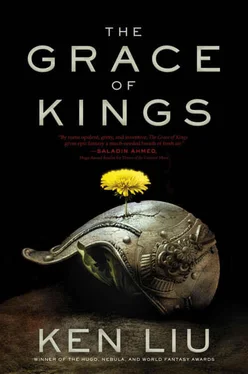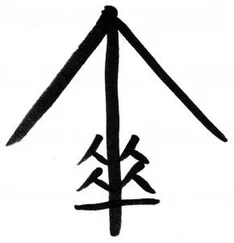“This is the life, eh?” said Ratho Miro. He smiled at the pretty girls cheering along the street.
“We haven’t met Xana’s real army yet,” said Dafiro Miro. “Don’t celebrate too early.”

The seeds of rebellion spread wherever the wind blew, and soon the conquered Tiro states re-emerged like fresh bamboo shoots after a long winter.
In the northern part of the Big Island, a man named Shilué, the grandchild of the last King of Faça, reclaimed the throne in Boama. His troops soon numbered ten thousand.
To the east, a descendant of a side branch of the ruling house of Gan declared himself King Dalo of Gan, land of wealth and culture. The Xana garrison in Toaza, the old Gan capital on the island of Wolf’s Paw, surrendered without a single arrow being shot. The garrison promptly renamed itself the Royal Gan Guard, and the former Xana commander happily accepted the title of count. Gan also seized the ships of the Xana navy docked at Toaza Harbor, and King Dalo prepared for an invasion of the Big Island to recover the rich alluvial plains of old Gan.
Meanwhile, the cities of the Maji Peninsula, south of the Sonaru Desert, declared themselves members of an independent league. As Maji had been under both Cocru and Gan administration at different times in its history, the cities shrewdly pledged partial allegiance to both Tiro states.
In the west, Amu, known for its elegance and sophistication, re-established itself on the beautiful island of Arulugi, though the former Amu territories on the Big Island remained firmly under Xana control.
The resurrected Rima quickly reclaimed its territory north of the Damu and Shinané mountain ranges with the aid of Faça. Rima soldiers also pushed as far as they dared to the southern side of the mountain ranges. The hope was that should Xana fall, Rima would now have the first claim on territories it had always disputed with old Amu.
Of the Six States, only Haan remained completely under Xana occupation. But there was a Haan government in exile, and King Cosugi of Haan, who had surrendered to the emperor Mapidéré when he was a young man thirty years ago, now lived in Çaruza as a guest of the newly established King Thufi of Cocru.
“You’ll soon see Ginpen again,” Thufi promised Cosugi.
Cosugi nodded, his wiry gray beard swaying and a pair of cloudy eyes peering nervously out of a face as dark and wrinkled as newly hardened lava, hardly able to believe this recent turn of events. Just a few months earlier, Xana had seemed invincible and the dream of reviving Haan a fairy tale.
Thufi invited all the kings of the reborn Six States to join him in Çaruza for a Grand Council of War. They would elect a princeps, and decide on the best course of action.
CHAPTER THIRTEEN. KINDO MARANA
THE BIG ISLAND: THE THIRD MONTH IN THE FOURTH YEAR OF THE REIGN OF RIGHTEOUS FORCE.
Kindo Marana never dreamed that he would one day have to put away his abacus, wear a suit of armor, and strap a sword to his belt.
He preferred watching the emperor’s treasury fill up with the money collected from all the Islands, not thinking about how to kill men in large numbers. He wanted to spend his time devising techniques for catching tax dodgers, not plotting strategy and examining casualty reports.
He had been a good student, showed a mind for figures, and worked his way diligently up the bureaucratic ladder. He enjoyed counting piles of coins and bushels of beans and bolts of cloth and jars of oil and bundles of dried fish and strings of shells and bags of rice and wheat and sorghum and sacks of wool and tins of fish scales. He found joy in classifying things, putting them in their rightful places, and checking their names off a list. He would have been happy doing that until he was old enough to retire.
But the regent was clear in his order. Somehow, a career bureaucrat who had never fought a single day in his life was now the Marshal of Xana, commander-in-chief of all of Xana’s forces on land, at sea, and in the air.
Well, a servant’s role was to discharge the duties of his post with diligence. He would begin with what he did best: an inventory of what he had to work with.
Nominally, Xana’s forces on land numbered one hundred thousand. But just as Kindo Marana’s yearly revenue projections for the treasury were never met, this number had to be discounted in several ways.
First, there was the matter of control. The only territories that the emperor still effectively held consisted of the Xana home islands of Dasu and Rui, Crescent Island in the northwest, Écofi Island in the southwest, and a butterfly-shaped slice of the middle of the Big Island, made up of the rich fields of Géfica and Géjira. The tall peaks of the Damu Mountains and the Shinané Mountains, and the broad expense of the Liru River and the rapids of Sonaru River, for now, held the rebels at bay — and the deadly expanse of the Gonlogi Desert also helped.
Haan, in the northwest corner of the Big Island, was also still completely under Imperial occupation. But the garrisons of the other territories had either surrendered and joined the rebels or were sealed in their cities and cut off from his command. They couldn’t be counted in the asset column of the ledger. The troops that he truly could command numbered only about ten thousand, consisting of the most loyal units around the Immaculate City.
Second, even in the areas that Xana still controlled, the situation was far from secure. The large number of prisoners and corvée laborers, forcefully conscripted from all over Dara to work on the Mausoleum and in the Grand Tunnels, could easily be turned into a rioting mob. They would welcome the rebels from their homelands as “liberators” if they should launch a coordinated attack on the Imperial heartland.
Third, the navy and the air force were in bad shape. The great airships were expensive to maintain and operate, as the lift gas leaked slowly but steadily from the silk gasbags, which had to be refilled periodically. Since there was only one source of lift gas in the whole world, scheduling the refill flights became a chore that many air force commanders avoided in peacetime. Except for the few airships that had accompanied Emperor Mapidéré on his constant tours, most of the Xana airships from the Unification Wars had been grounded for years. The navy was also barely a shell of its former self. Except for those patrolling for pirates in the north, the navy’s ships had sat in docks for years, infested by shipworms and barely afloat. These were yet more liabilities.
Finally, morale was abysmal. Marana understood well how the way a man felt about something affected the way he went about doing it. Back when Xana was still only one Tiro state among seven, not an empire, the people of Xana had resented the way the other Islanders treated them as unsophisticated rubes, semi-barbaric poor cousins. When King Réon began his wars of conquest and the taxes had to be raised to support them, there was a palpable sense of purpose among the populace that Xana had to fight for its rightful place in Dara, and the people paid the tax collectors almost willingly. This changed quickly under the peace of the empire. And right now, that sense of hope and purpose belonged to the rebels of the Six States, while Xana soldiers were on the run, depressed, and uncertain about the justness of their cause.
Having tallied up the balance sheet, Marana methodically went about improving it. That was a task he was familiar with. During the later years of the Reign of One Bright Heaven, and especially now, the Reign of Righteous Force, the palace made many unreasonable demands of the Treasury. Yet, he had somehow always found ways to fulfill them.
Читать дальше













